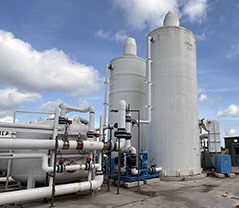In modern industrial water treatment, advancements in technology and processes have revolutionized the way contaminants are removed from water.
This blog explores the integration of NSF/ANSI 61 certified systems, artificial intelligence in water treatment, and cutting-edge processes such as decarbonation and degasification. We'll also discuss the key differences between forced draft and induced draft degasification towers, helping you make informed decisions while designing your Industrial Water Treatment System.
-
NSF/ANSI 61-Certified Water Treatment Systems: To ensure the safety and quality of water treatment equipment, NSF/ANSI 61 certification has become a crucial standard. This certification verifies that materials and components used in water treatment systems comply with health and safety requirements. When selecting a water treatment solution, opting for NSF/ANSI 61 certified systems guarantees peace of mind and adherence to the highest industry standards.
-
Harnessing Artificial Intelligence in Water Treatment: Artificial intelligence (AI) has penetrated various industries, and water treatment is no exception. Integrating AI into water treatment processes allows for more efficient and optimized operations. AI-driven systems can monitor water quality in real-time, predict system failures, optimize chemical dosing, and reduce energy consumption. By leveraging AI technologies, water treatment facilities can enhance their overall performance and streamline resource utilization.
-
Decarbonation and Degasification Systems: Decarbonation and degasification are essential processes in industrial water treatment, particularly in pH levels in water and the ability to control removing the contaminants. These processes target the removal of carbon dioxide (CO2) and other dissolved gases from water to improve its quality. Two key systems used for this purpose are the decarbonator and aeration system.
Read More
Topics:
degasification,
advanced treatment solutions,
biological scrubber,
NSF/ANSI 61,
Chemical Odor,
Decarbonation,
Safe drinking water,
De-Aeration,
decarbonator,
degasifier,
degassed water,
ansi61,
nsf/ansi61,
Deagasification,
decarbonation of water,
DeLoach Industries, Inc.,
Drinking Water,
Industrial Odor Control,
DeLoach Industries,
contaminants,
process system,
safe drinking water act,
drinking water standards,
environmental safety,
air emissions,
Forced Draft,
Induced Draft

Following NSF/ANSI 61 regulations when designing and selecting the materials for the manufacturing of water treatment equipment.
It is important to understand what regulatory standards or constructions standard may be required to be compliant. This includes the designing and fabrication of systems such as reverse osmosis utilizing membrane technology, decarbonation of Carbon Dioxide, degasification of Hydrogen Sulfide, and water filtration for the removal of micron particles from potable and nonpotable water processes.
One requirement that engineers and manufacturers often encounter is called NSF /ANSI 61. NSF is an international and nonprofit, nongovernmental organization that is focused and dedicated to public health and safety as it relates to potable water systems and their components. NSF/ANSI 61 developed and established minimum requirements for the control of potential adverse human health effects from products and their components that contact with drinking water.
DeLoach Industries Inc. manufactures multiple types of water treatment equipment and adheres to strict compliance with NSF/ANSI 61 standards with all of their manufacturing procedures and practices. This strict adherence assures owners that water treatment equipment like decarbonation and degasification towers, reverse osmosis, and ion exchange that the equipment and material are all in full compliance with the NSF/ANSI 61 requirements.
Read More
Topics:
water quality,
water treatment,
advanced treatment solutions,
About DeLoach Industries,
fabrication,
contact molded process,
hydrogen sulfide (H2S),
Decarbonation,
wastewater,
carbon dioxide,
decarbonator,
H2S Degasifier,
ansi61,
nsf/ansi61





